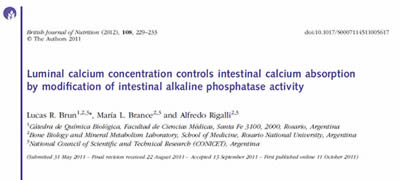Cite: Brun LR, Brance ML, Rigalli A. Luminal calcium concentration controls intestinal calcium absorption by modification of intestinal alkaline phosphatase activity. Br J Nutr. 2012 Jul;108(2):229-33. doi: 10.1017/S0007114511005617. Epub 2011 Oct 11. PMID: 22018098. PubMed
Abstract
Intestinal alkaline phosphatase (IAP) is a brush-border phosphomonoesterase. Its location suggests an involvement in the uptake of nutrients, but its role has not yet been defined. IAP expression parallels that of other proteins involved in Ca absorption under vitamin D stimulation. Experiments carried out in vitro with purified IAP have demonstrated an interaction between Ca and IAP. The gut is prepared to face different levels of Ca intake over time, but high Ca intake in a situation of a low-Ca diet over time would cause excessive entry of Ca into the enterocytes. The presence of a mechanism to block Ca entry and to avoid possible adverse effects is thus predictable. Thus, in the present study, Sprague-Dawley rats were fed with different amounts of Ca in the diet (0.2, 1 and 2 g%), and the percentage of Ca absorption (%Ca) in the presence and absence of L-phenylalanine (Phe) was calculated. The presence of Phe caused a significant increase in %Ca (52.3 (SEM 6.5) % in the presence of Phe v. 31.1 (sem 8.9) % in the absence of Phe, regardless of the amount of Ca intake; paired t test, P = 0.02). When data were analysed with respect to Ca intake, a significant difference was found only in the group with low Ca intake (paired t test, P = 0.03). Additionally, IAP activity increased significantly (ANOVA, P < 0.05) as Ca concentrations increased in the duodenal lumen. The present study provides in vivo evidence that luminal Ca concentration increases the activity of IAP and simultaneously decreases %Ca, acting as a minute-to-minute regulatory mechanism of Ca entry.

